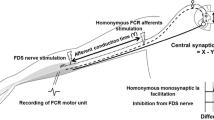Abstract
Neural projection from the brachioradialis to the biceps brachii motoneurones in human was studied using the method of post-stimulus time histogram. Electrical stimulation to the radial branch innervating the brachioradialis produced inhibition in 11 out of 21 biceps motor units. The central delays of the inhibition were 0.7–1.2 ms longer than those of the homonymous facilitation. The inhibition was evoked with the intensity below the motor threshold. Pure cutaneous stimulation provoked no effects on the motor-unit firing. These findings suggest that group I afferents from the brachioradials mediate an oligosynaptic inhibition of the biceps brachii motoneurones.
Similar content being viewed by others
References
Aymard C, Chia L, Katz R, Lafitte C, Penicaud A (1995) Reciprocal inhibition between wrist flexors and extensors in man: a new set of interneurones? J Physiol (Lond) 487:221–235
Baldissera F, Campadelli P, Cavallari P (1983) Inhibition of H-reflex in wrist flexors by group I afferents in the radial nerve. Electromyogr Clin Neurophysiol 23:187–193
Basamajian JV, Deluca CJ (1985) Muscles alive. 5th edn. Williams & Wilkins, Baltimore London Sydney
Buchanan TS, Rovai GP, Rymer WZ (1989) Strategies for muscle activation during isometric torque generation at the human elbow. J Neurophysiol 62:1201–1212
Caldwell GE, Jamison JC, Lee S (1993) Amplitude and frequency measures of surface electromyography during dual task elbow torque production. Eur J Appl Physiol 66:349–356
Cavallari P, Katz R (1989) Pattern of projections of group I afferents from forearm muscles to motoneurones supplying biceps and triceps muscles in man. Exp Brain Res 78:465–478
Cavallari P, Katz R, Penicaud A (1992) Pattern of projections of Group I afferents from elbow muscles to motoneurones supplying wrist muscles in man. Exp Brain Res 91:311–319
Cnockaert JC, Lensel G, Pertuzon E (1975) Relative contribution of individual muscles to the isometric contraction of a muscular group. J Biomechanics 8:191–197
Day BL, Marsden CD, Obeso JA, Rothwell JC (1984) Reciprocal inhibition between the muscles of the human forearm. J Physiol (Lond) 349:519–534
Ellaway PH (1978) Cumulative sum technique and its application to the analysis of peristimulus time histograms. Electroenceph Clin Neurophysiol 45:302–304
Fournier E, Meunier S, Pierrot-Deseilligny E, Shindo M (1986) Evidence for interneuronally mediated Ia excitatory effects to human quadriceps motoneurones. J Physiol (Lond) 377:143–169
Gielen CCAM, van Zuylen EJ (1986) Coordination of arm muscles during flexion and supination: Application of the tensor analysis approach. Neuroscience 17:527–539
Hebert LJ, De Serres SJ, Arsenault AB (1991) Cocontraction of the elbow muscles during combined tasks of pronation-flexion and supination-flexion. Electromyogr Clin Neurophysiol 31:483–488
Jamison JC, Caldwell GE (1993) Muscle synergies and isometric torque production: Influence of supination and pronation level on elbwo flexion. J Neurophysiol 70:947–960
Jankowska E, McCrea D (1983) Shared reflex pathways from Ib tendon organ afferents and Ia muscle spindle afferents in the cat. J Physiol 338:99–111
Katz R, Penicaud A, Rossi A (1991) Reciprocal Ia inhibition between elbow flexors and extensors in the human. J Physiol (Lond) 437:269–286
Miyasaka T, Sun Y-J, Naito A, Morita H, Shindo M, Shimizu Y, Yanagisawa N (1995) Reciprocal inhibition between biceps brachii and brachioradialis in the human. In abstract, 4th IBRO World Congress of Neuroscience, p 334
Naito A, Sun Y-J, Shimizu Y (1994) Electromyographic activities of the elbow flexors and extensors during forearm supination and pronation movements. In abstract, 14th International Congress of Anatomist, p 572
Naito A, Yajima M, Fukamachi H, Ushikoshi K, Sun Y-J, Shimizu Y (1995) Electromyographic (EMG) study of the elbow flexors during supination and pronation of the forearm. Tohoku J Exp Med 175:285–288
Rossi A, Decchi B, Zalaffi A, Mazzocchio R (1995) Group Ia nonreciprocal inhibition from wrist extensor to flexor motoneurones in humans. Neurosci Lett 191: 205–207
Sergio LE, Ostry DJ (1994) Coordination of mono- and bi-articular muscles in multi-degree of freedom elbwo movements. Exp Brain Res 97:551–555
Sherrington CS (1906) The integrative action of the nervous system. Yale University Press, New Haven
Zuylen EJ van, Gielen CCAM, Denier van der Gon JJ (1988) Coordination and inhomogeneous activation of human arm muscles during isometric torques. J Neurophysiol 60:1523–1548
Author information
Authors and Affiliations
Rights and permissions
About this article
Cite this article
Naito, A., Shindo, M., Miyasaka, T. et al. Inhibitory projection from brachioradialis to biceps brachii motoneurones in human. Exp Brain Res 111, 483–486 (1996). https://doi.org/10.1007/BF00228739
Received:
Accepted:
Issue Date:
DOI: https://doi.org/10.1007/BF00228739




